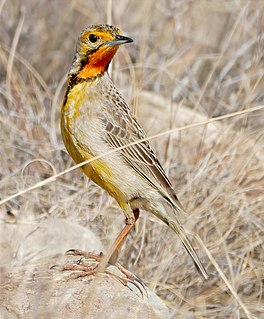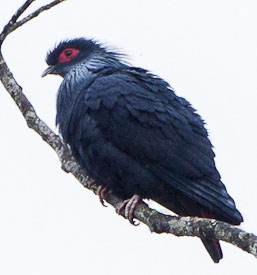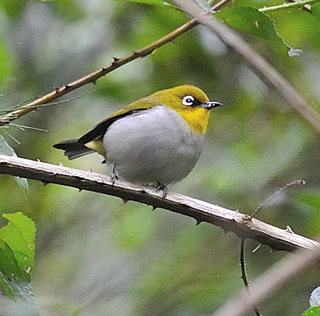
The mosque swallow is a large swallow. It is a resident breeder in much of sub-Saharan Africa, although most common in the west. It does not migrate but follows the rains to some extent.

The woodland kingfisher is a tree kingfisher that is widely distributed in Africa south of the Sahara.

The stork-billed kingfisher, is a tree kingfisher which is widely but sparsely distributed in the tropical Indian subcontinent and Southeast Asia, from India to Indonesia. This kingfisher is resident throughout its range.

The African grey hornbill is a member of the hornbill family of tropical near-passerine birds found in the Old World. It is a widespread and common resident breeder in much of Sub-Saharan Africa and into Arabia. The African grey hornbill has escaped or been deliberately released into Florida, USA, but there is no evidence that the population is breeding and may only persist due to continuing releases or escapes.

The white-winged snowfinch, or snowfinch, is a small passerine bird. Despite its name, it is a sparrow rather than a true finch.

The Cape longclaw or orange-throated longclaw is a passerine bird in the family Motacillidae, which comprises the longclaws, pipits and wagtails. It occurs in Southern Africa in Zimbabwe and southern and eastern South Africa. This species is found in coastal and mountain grassland, often near water.

The southern fiscal, common fiscal or fiscal shrike is a member of the shrike family found through most of Sub-Saharan Africa. It is also sometimes named jackie hangman or butcher bird due to its habit of impaling its prey on acacia thorns to store the food for later consumption. It was previously lumped together with the northern fiscal. Together they were known as the common fiscal.

The shaft-tailed whydah or queen whydah is a small, sparrow-like bird in the genus Vidua. During the breeding season the male has black crown and upper body plumage, golden breast and four elongated black tail shaft feathers with expanded tips. After the breeding season is over, the male sheds its long tail and grows olive brown female-like plumage.

The red fody, also known as the Madagascar fody in Madagascar, red cardinal fody in Mauritius, or common fody, is a small bird native to Madagascar and introduced to various other islands in the Indian Ocean. It is a common bird within its restricted range, and the International Union for Conservation of Nature has assessed its conservation status as being of "least concern".

The Cape bunting is a passerine bird in the bunting family Emberizidae.

The violet-eared waxbill or common grenadier is a common species of estrildid finch found in drier land of Southern Africa.

The Cape wagtail, also known as Wells's wagtail, is a small insectivorous bird which is widespread in southern Africa. It frequents water's edge, lawns and gardens. It is a mostly resident, territorial species, but has been known to undertake limited altitudinal migration or form flocks outside of the breeding season. Like other wagtails they are passerine birds of the family Motacillidae, which also includes the pipits and longclaws.

The brimstone canary or bully canary is a small passerine bird in the finch family. It is a resident breeder in central and southern Africa.

The Madagascar blue pigeon is a species of bird in the family Columbidae. The species is closely related to the other two extant species of blue pigeon, the Comoros blue pigeon and the Seychelles blue pigeon. It is endemic to northern and eastern Madagascar.

The crested drongo is a passerine bird in the family Dicruridae. It is black with a bluish-green sheen, a distinctive crest on the forehead and a forked tail. There are two subspecies; D. f. forficatus is endemic to Madagascar and D. f. potior, which is larger, is found on the Comoro Islands. Its habitat is lowland forests, both dry and humid, and open savannah country. It is a common bird and the IUCN has listed it as "least concern".

The scarlet-chested sunbird is a species of bird in the family Nectariniidae.

The rufous vanga is a species of bird in the family Vangidae. It is monotypic within the genus Schetba. It is endemic to Madagascar, where its natural habitats are subtropical or tropical dry forest and subtropical or tropical moist lowland forest.

The Malagasy paradise flycatcher is a species of bird in the family Monarchidae. It is found in Comoros, Madagascar, and Mayotte. Its natural habitats are subtropical or tropical dry forest and subtropical or tropical moist lowland forest.

The Malagasy white-eye is a species of bird in the white-eye family, Zosteropidae. Found in the Comoros, Madagascar, Mayotte, and Seychelles, its natural habitats are subtropical or tropical dry forests, subtropical or tropical moist lowland forests, subtropical or tropical mangrove forests, and subtropical or tropical moist montane forests.

The Réunion olive white-eye is a species of bird in the family Zosteropidae. It is found on Réunion. Its natural habitats are boreal forests and subtropical or tropical high-altitude grassland.
























